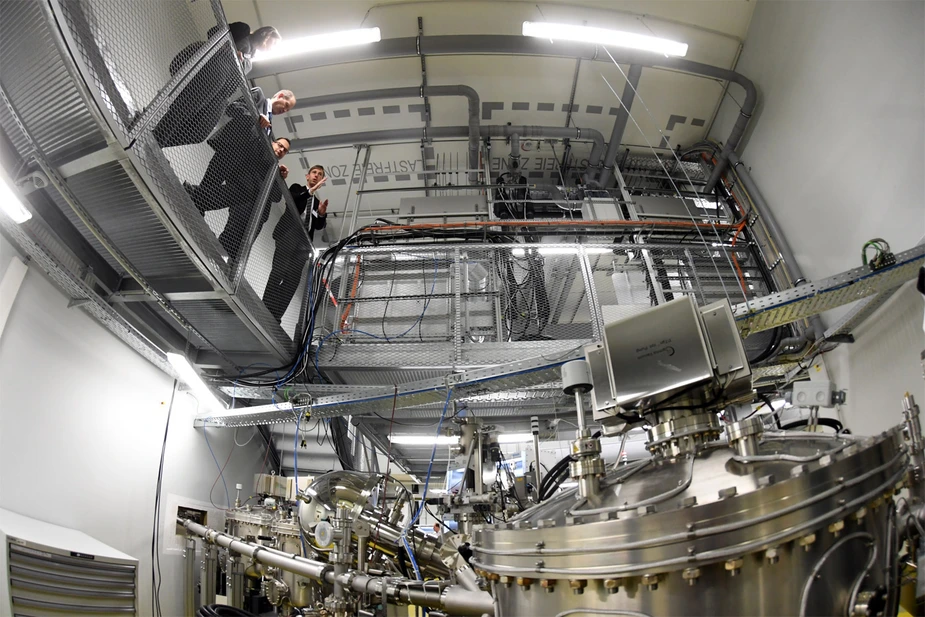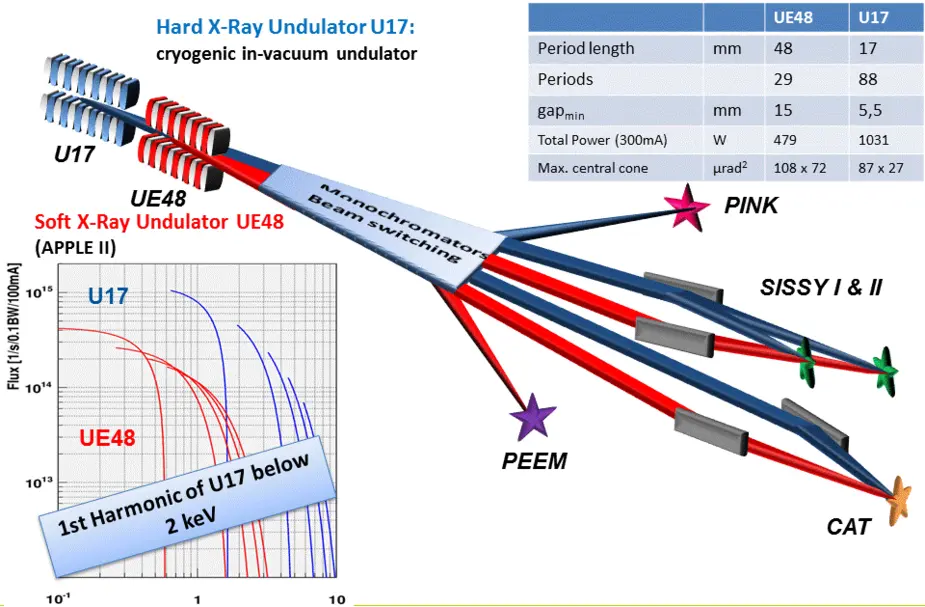Breakthrough at EMIL
First undulator radiation in the CAT experiment
When the EMIL laboratory (Energy-Materials In-Situ Laboratory Berlin) was ceremoniously inaugurated a year ago in the presence of Federal Minister for Research Johanna Wanka, it was a major milestone for energy materials research at HZB. Ever since, HZB has been building the system that will bring X-ray beams all the way from BESSY II to the EMIL apparatuses. Until the BESSY light is fully available, the scientists have been working with X-rays from a conventional laboratory source. Now, the beamline operators have succeeded in guiding the X-rays from Undulator UE48 in the BESSY II experimental hall to the CAT experiment in the EMIL laboratory. There, it was quantitatively measured using a focus measuring chamber.
“All parameters important for later experimental operation, such as beam diameter (108 x 56 µm2), photon flux (approx. 1012 s-1) and resolution (50 meV at 400 eV) satisfy the expectations and calculated values,” says the responsible project manager, Dr. Franz Schäfers.
The beamline thus promises to be one of the most powerful in this energy range. There are two beamlines in total for bringing X-ray light from BESSY II to the EMIL laboratory. In providing the link between light source and experiment, they have to satisfy a plethora of requirements. The two beamlines leading to EMIL@BESSY II, Schäfers asserts, are “among the most complex optical components that have ever been built onto a storage ring for synchrotron radiation.” There are many reasons for this complexity:
The EMIL beamlines
The soft and hard X-ray radiation is produced in two different magnetic components in the storage ring called undulators. It is directed through two separate beamlines, monochromatised, focused, and then reunited into a single point. This is done at the three focusers SISSY-I, SISSY-II and CAT. There are furthermore two additional experimental stations that use either the soft (PEEM) or hard (PINK) radiation separately. This diverse choice of beam switching is made possible by a huge number of optical elements including (deflection) mirrors, diffraction gratings, and crystals. The optical specifications of these components were first verified in an in-house optics laboratory and then calibrated by making precision adjustments in ultra-high vacuum (UHV) chambers.
Because X-rays can only be deflected at small angles, the entire beamline system had to be built over a long, narrow corridor. Accordingly, no fewer than 6 beamlines with 17 UHV chambers and 26 optical elements now extend over an area one metre wide and 60 metres long, and the whole thing rests on three different foundations. The entire UHV beamline system is approximately 180 metres long.
This latest milestone has the entire EMIL team eager with anticipation over the laboratory complex’s final completion. But there is still much to do before then, says Franz Schäfers. “Next, we have to switch the BESSY light from Undulator UE48 by another deflection mirror to the SISSY-I focuser. Undulator U17 for hard X-rays is expected to be installed during the coming winter shutdown in mid December 2017.”
This beamline, however, is even more complex than the one described above. It features not only a plane grating monochromator for the first harmonics between 700 eV and 2000 eV, but also a double crystal monochromator (DCM) for the radiation at higher harmonics above 2000 eV. A great deal of heat is generated at the first monochromator, so liquid nitrogen cooling is required. This cooling technology has never had to be used before at BESSY II.
The two monochromators in the U17 hard X-ray line will operate alternately, while the two undulators will be used simultaneously in order to feed two experiments at the same time.
In the EMIL laboratory, HZB researchers and their cooperation partners are dedicated to the synthesis and in-situ/in-operando X-ray analysis of materials of relevance for energy conversion and energy storage. Most of this will be done in the SISSY laboratory of HZB. Researchers in the CAT laboratory of the Max Planck Society (MPG) are furthermore studying catalytic processes for energy conversion under realistic conditions (ambient pressure).
Watch our two-minute video on YouTube and that shows the possibilities EMIL offers.
Further information:
Helmholtz-Zentrum Berlin für Materialien und Energie
Energy Materials In-Situ Laboratory Berlin (EMIL)
www.helmholtz-berlin.de/projects/emil/

